For her master’s thesis in “Professions in teaching, education and training”, Mylène Trouillet, now a schoolteacher, chose the topic of using archaeology to teach science in elementary school.
Summary of the thesis
Teaching science has become a priority for the French National Education system. It is now essential for teachers to implement the classroom investigation process to allow pupils to develop scientific curiosity and reasoning. However, it is not easy for all teachers to put this type of approach into practice.
This thesis presents the construction and the study of an educational sequence of 5 interdisciplinary learning sessions, , combining teaching of the investigative process and traditional teaching (French, mathematics, history, TUIC* and education for sustainable development).
*TUIC: Common Information and Communication Techniques
From the archaeological discipline and the theme of water supply in the gallo-roman period being used as a foundation for teaching the investigative process, Mylène Trouillet tested her research hypotheses aiming at:
- Increase pupils’ motivation
- Reduce the fear of the teacher who can feel powerless in the teaching of science
- Evaluate the contributions and limits of interdisciplinary work
- Evaluate the use of project pedagogy as a tool for identifying gaps in pupils’ knowledge in French and mathematics
The analysis of the data was based on the collection of initial (pre-test) and final (post-test) conceptions as well as on the comparison of two filmed sessions: one conducted during a traditional French class and the other during a science class in “project pedagogy” format.
![]() Download the thesis in French in PDF format.
Download the thesis in French in PDF format.
Keywords
Archaeology, investigative process, science education, project pedagogy, 5th grade, elementary school (4th and 5th grade)
To cite the thesis
Trouillet M. (mai 2015), L’application de la démarche d’investigation au service de l’interdisciplinarité et de la motivation des élèves au cycle 3, Mémoire de Master « Métiers de l’enseignement, de l’éducation et de la formation », sous la direction du Pr. Faouzia Kalali et du Dr. Jean-Olivier Gransard-Desmond, Centre de Mont-Saint-Aignan ou Le Havre ou Évreux, Université de Rouen – ESPE, Académie de Rouen, 162 p.
To find out more…
 About the teaching experiment by accessing the presentation on the Expérithèque or by writing to Mylène Trouillet
About the teaching experiment by accessing the presentation on the Expérithèque or by writing to Mylène Trouillet About ArkéoTopia by watching our institutional video or by writing to us at contact@arkeotopia.org
About ArkéoTopia by watching our institutional video or by writing to us at contact@arkeotopia.org
Submit a thesis or a scientific article for the ArkéoLog and for the website
If you are an archaeologist, art historian, historian, anthropologist, professional or volunteer, or if you come from another domain, but your topic relates to human history or the didactics of sciences and sciences of education, you can submit your thesis or article to us by writing to redaction@arkeotopia.org and respecting the following specifications:
- Topic is related to archaeology for teaching science and the science of education, or to human history for other domains
- Provide a summary of 500 characters (including spaces) and 7 keywords maximum
- Not to exceed 5000 words (excluding annexes and references) for articles (no limitation for a thesis)
- Provide a text in an ODT– OpenOffice format or equivalent for articles, and in a PDF format for a thesis, not exceeding 50 MB including annexes
- Provide illustrations in a jpg or png format, respecting a minimal size of 10cm in height for 300 dpi
- Provide an ODS format for table









